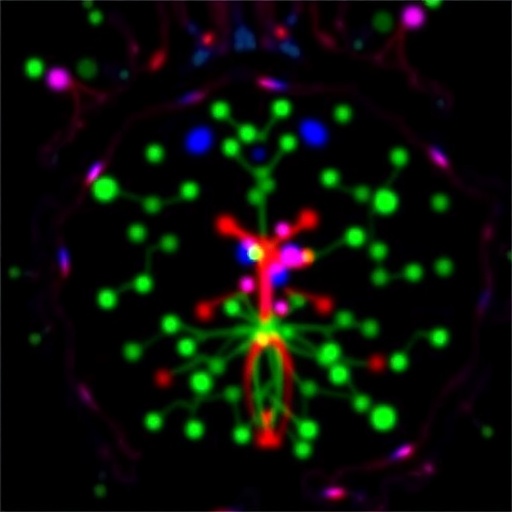In a groundbreaking study that bridges the fields of neuroscience and oncology, researchers have unveiled critical insights into how primary brain cancers known as gliomas interweave with neural circuits, revealing a nuanced relationship between tumor aggressiveness and the excitability of the surrounding brain tissue. Gliomas, notoriously invasive and stubbornly incurable, not only disrupt healthy brain architecture by infiltrating neural tissue but also appear to hijack the brain’s own signaling networks, effectively turning the nervous system into a breeding ground for cancer proliferation.
This pioneering work, conducted by McAlpine, Rosier, Rozario, and colleagues and published in Nature Neuroscience, employs cutting-edge patch-clamp electrophysiology to explore the electrophysiological dynamics within human glioma-infiltrated cortex. Specifically, the study compares neurons and glial tumor cells in samples from patients with either low-grade or high-grade gliomas—a crucial stratification as these tumors vary not only histopathologically but also in their molecular profiles and growth patterns. The results challenge and enrich previous conceptions by showing that neurons within high-grade gliomas exhibit markedly increased excitability compared to those found in low-grade tumors, suggesting a direct functional interplay that may fuel the cancer’s rapid expansion.
By meticulously measuring the electrical responses of pyramidal neurons—which are the principal excitatory neurons in the cortex—and glioma cells, the team demonstrated that the biophysical characteristics of these brain cells diverge significantly depending on the tumor grade. Neurons in high-grade glioma environments did not just display a heightened readiness to fire action potentials; they also contributed to larger and more sustained synaptic events in the adjacent glioma cells. Such a finding hints at a pathological form of synaptic integration, where glioma cells co-opt normal neural communication pathways to promote their own survival and proliferation.
Unlike low-grade gliomas, which appear to maintain a somewhat restrained level of interaction with adjacent neurons, high-grade glioma cells manifest synaptic currents that are smaller in amplitude but last longer, indicating a shift in the synaptic dynamics within the cancer niche. This synaptic reprogramming likely plays a role in creating a network that is conducive to the tumor’s aggressive growth. The persistence and duration of these synaptic responses may enable glioma cells to continuously receive excitatory input, driving pathological changes in tumor behavior.
One of the more striking discoveries is the hyperexcitability of pyramidal neurons embedded in the high-grade glioma cortex. This heightened excitability does not merely represent a passive byproduct of tumor presence; it actively promotes glioma proliferation. The research team posits a feed-forward loop where increased neuronal firing exacerbates glioma growth, which in turn could further intensify network hyperexcitability. Such a vicious cycle underscores the complexity of brain tumor biology and opens novel avenues for potential therapeutic interventions aimed at modulating neural activity.
From a methodological standpoint, these insights were made possible through rigorous electrophysiological recordings directly from human tissue samples. Patch-clamp techniques allowed direct interrogation of synaptic currents and action potential firing, providing an unparalleled window into the dynamic interactions at play. Importantly, this study moves beyond animal models, furnishing essential data on human brain activity in the context of cancer, which is critical for translating findings into clinical interventions.
The implications of these findings extend far beyond basic science, having profound clinical ramifications. Understanding how gliomas leverage neural excitability and synaptic integration to accelerate their growth presents an opportunity to innovate treatments that could disrupt these pathological brain-tumor networks. For instance, targeting synaptic activity pharmacologically or through neuromodulation techniques may slow tumor progression by disrupting this pernicious communication channel.
Furthermore, this research reshapes the conceptual framework around gliomas by framing them not just as independent pathological masses but as active participants in the neural microenvironment. It challenges researchers and clinicians alike to consider how circuit-level changes in the brain contribute to disease progression and to incorporate these complexities into the design of future diagnostic and therapeutic strategies.
The differentiation in neuronal behavior between low-grade and high-grade gliomas also provides a potential biomarker for tumor aggressiveness. Recording and analyzing the electrophysiological signatures in tumor-adjacent cortex could one day inform clinicians about tumor grade and progression rates without solely relying on invasive biopsies, thus refining prognosis and treatment plans.
Moreover, this study exemplifies the increasingly interdisciplinary nature of contemporary biomedical research, merging neurophysiology and oncology to address a long-standing medical challenge. The collaboration highlights the importance of probing the microenvironmental context in which cancers evolve, emphasizing not only cellular genetics but also functional circuit dynamics.
While previous research has hinted at the role of glutamatergic signaling in glioma progression, the current study provides definitive functional evidence of neuron-glioma synaptic activity in human cortical tissue. This supports the hypothesis that gliomas exploit excitatory neurotransmission to enhance their malignancy, providing new targets such as synaptic receptors or associated signaling pathways for therapeutic blockade.
Future research inspired by these findings may explore whether interventions to dampen neuronal excitability can serve as adjunctive treatments alongside conventional therapies like surgery, radiation, and chemotherapy. Such approaches could potentially contain tumor spread or improve patient outcomes by breaking the deleterious neuron–glioma feedback loop.
Additionally, a deeper understanding of the molecular mechanisms that underlie the altered synaptic currents in glioma cells may reveal novel oncogenic signaling cascades. Decoding how these cancer cells remodel synaptic physiology could yield new molecular targets amenable to drug development.
This seminal work by McAlpine and collaborators thus not only advances fundamental neuroscience by uncovering a new dimension of brain-tumor interaction but also sparks hope for the millions affected by gliomas worldwide. It reconceptualizes brain cancers as aberrant neuro-glial networks, highlights the critical role of neural activity in tumor biology, and challenges the scientific community to rethink therapeutic paradigms for one of the most devastating forms of cancer.
As the scientific community digests these revelations, it is becoming increasingly clear that the future of glioma treatment lies in a multidisciplinary approach that integrates electrophysiology, molecular biology, and clinical oncology. This study paves the path toward innovative treatment strategies that could one day transform fatal brain cancers into manageable chronic conditions by targeting the circuitry that tumors exploit.
Subject of Research: Neural excitability and synaptic activity in glioma-infiltrated human cortex and their impact on glioma proliferation.
Article Title: Increased neural excitability and glioma synaptic activity drives glioma proliferation in human cortex.
Article References:
McAlpine, H., Rosier, M., Rozario, J. et al. Increased neural excitability and glioma synaptic activity drives glioma proliferation in human cortex. Nat Neurosci (2025). https://doi.org/10.1038/s41593-025-02149-0
Image Credits: AI Generated
DOI: https://doi.org/10.1038/s41593-025-02149-0
Tags: brain architecture disruption by gliomascancer proliferation in the nervous systemelectrophysiology in glioma researchglioma infiltration in brain tissuehigh-grade vs low-grade gliomasinsights into glioma invasiveness and treatment challengesinteractions between neurons and glial tumor cellsneural excitability and glioma growthpatch-clamp technique in neuroscienceprimary brain cancer and neurosciencerelationship between tumors and neural circuitstumor aggressiveness and brain signaling





